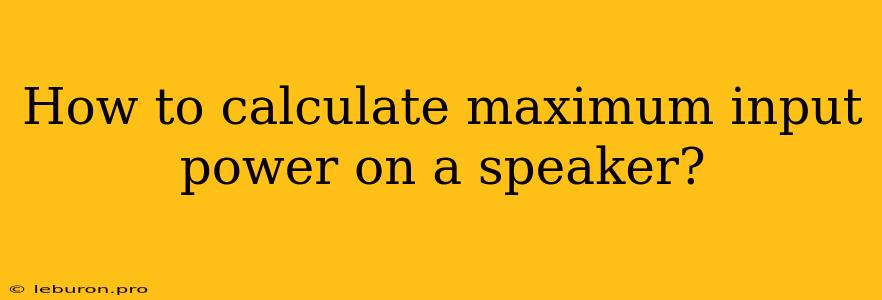Determining the maximum input power a speaker can handle is crucial for ensuring its longevity and optimal performance. Exceeding a speaker's power handling capacity can lead to damage, including blown drivers, distorted sound, and even a complete failure of the speaker system. This article delves into the intricacies of understanding and calculating maximum input power on a speaker. We'll explore the different factors involved, provide practical guidance, and shed light on the importance of respecting these limits to safeguard your audio equipment.
Understanding Power Handling Capacity
The maximum input power on a speaker refers to the amount of power the speaker can handle without experiencing damage or significant distortion. This is not to be confused with the speaker's sensitivity rating, which measures how efficiently the speaker converts electrical energy into sound.
Program Power and Continuous Power
Two primary power ratings are commonly used to describe a speaker's power handling capacity:
- Program Power: This rating represents the maximum amount of power the speaker can handle for short bursts, typically associated with music signals that have peaks and valleys.
- Continuous Power: This rating indicates the maximum amount of power the speaker can handle continuously without experiencing damage.
It's essential to note that program power is usually higher than continuous power, reflecting the fact that speakers can withstand higher power levels for brief periods. However, exceeding the continuous power rating for extended durations can result in serious damage.
Factors Affecting Maximum Input Power
Several factors influence the maximum input power on a speaker:
- Driver Size: Larger drivers, with larger cones and voice coils, can typically handle more power.
- Voice Coil Material: Voice coils made from robust materials like copper or aluminum can withstand higher temperatures and power levels.
- Speaker Enclosure: Well-designed enclosures, especially sealed or ported enclosures, provide better protection for the drivers and improve overall power handling capacity.
- Impedance: Lower impedance speakers generally require more power to achieve the same volume levels, so they may have higher power handling ratings.
- Cooling System: Effective cooling systems help dissipate heat generated by the voice coil, preventing it from overheating and damaging the speaker.
Calculating Maximum Input Power
While a speaker's power rating provides a starting point, there's no single formula to accurately calculate maximum input power on a speaker. However, considering the following factors can give you a better understanding of its power handling capabilities:
- Speaker Sensitivity: A speaker's sensitivity rating (measured in dB SPL per watt at 1 meter) indicates its efficiency. More sensitive speakers require less power to produce a certain volume level.
- Amplifier Power Output: The amplifier powering the speaker must be capable of delivering enough power to achieve the desired volume without clipping.
- Listening Environment: The size and acoustics of the listening room can affect the required power output. A larger room or one with poor acoustics may require more power for optimal sound.
- Personal Preference: Different listeners have varying preferences for volume levels.
Practical Guidelines for Power Handling
To ensure your speaker system functions properly and avoids damage, follow these practical guidelines:
- Respect the Speaker's Ratings: Always adhere to the specified program and continuous power ratings of your speakers.
- Amplifier Power Matching: Choose an amplifier with power output that's slightly higher than the speaker's continuous power rating. This provides ample headroom for peak volume levels without overloading the speakers.
- Avoid Clipping: Carefully adjust the amplifier's volume control to avoid clipping, which occurs when the amplifier signal is distorted due to exceeding its power output.
- Monitor Sound Quality: Listen closely for any signs of distortion, such as crackling, buzzing, or a general loss of clarity. These are indicators that you might be pushing the speakers too hard.
- Invest in Quality: High-quality speakers with robust components and well-designed enclosures are more likely to handle higher power levels without damage.
Conclusion
Determining the maximum input power on a speaker is crucial for safeguarding your audio equipment and achieving optimal performance. By understanding the factors that influence power handling capacity, respecting the specified ratings, and employing prudent practices, you can ensure your speakers remain in top condition for years to come. Remember, careful attention to power levels and responsible use are the keys to a long and enjoyable listening experience.
